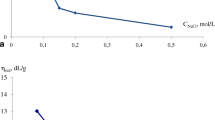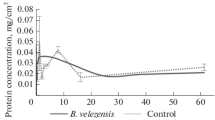The dispersion characteristics of kaolin from the Zhuravlinyi Log deposit, as well as the ξ -potential and the apparent viscosity of suspensions based on it, were investigated. Kaolin suspensions had a sufficiently high stability due to the negative charge of the surface of the particles. The ξ-potential was determined as a function of pH and tripolyphosphate concentration by the electrophoresis method. The effectiveness of the additive on the apparent viscosity of the suspension is associated with the ability to increase the pH and hence the ξ -potential. The isoelectric point of kaolin is set to 3.28. The kaolin slurry had a fairly high casting rate, which can be explained by the good crystallization of the mineral (Hinckley index 1.76).






Similar content being viewed by others
References
F. Demir, Crude kaolin dissolution in the absence and presence of sodium poly (acrylic acid), sodium hexametaphosphate, and sodium silicate under different experimental conditions,” Clays and Clay Minerals, 64(6), 753 – 766 (2016).
A. A. Sikorskii, A. V. Mironyuk, and V. A. Sviderskii, “Rheological behavior of aqueous suspensions of kaolin in the presence of surfactants,” Technol. Audit Product. Res., No. 2/1(10), 45 – 48 (2013).
V. Gupta, M. A. Hampton, J. R. Stokes, et al., “Particles interactions in kaolinite suspensions and corresponding aggregate structures,” J. Colloid Interface Sci., 359, 95 – 103 (2011).
V. Õnen, M Gõçer, and H. A. Taner, “Effect of coagulants and flocculants on dewatering of kaolin suspensions,” Omer Halisdemir Univ. J. Eng. Sci., 7(1), 297 – 305 (2018).
M. A. Sokolov, N. M. Kuznetsov, S. I. Belousov, and S. N. Chvalun, “Effect of dispersion medium viscosity on the electrorheological behavior of halloysite suspensions in polydimethylsiloxane,” Izv. Vyssh. Ucheb. Zaved., Khimiya Khim. Tekhnol., 64(11), 79 – 85 (2021).
B. L. Krasnyi, T. S. Marinina, and A. L. Galganova, “Some features of the formation of porous permeable ceramics by the slip casting method,” Novye Ogneupory, No. 6, 43 – 46 (2015).
I. V. Pishch, Yu. A. Klimosh, and E. V. Gabalov, “Effect of diluting additives on the rheological properties of ceramic slips,” Trudy BGTU, No. 3, 106 – 109 (2013).
X. Zhu, Zh. Zhu, X. Lei, and Ch. Yan, “Defects in structure as the sources of the surface charges of kaolinite,” Appl. Clay Sci., 124 – 125, 127 – 136 (2016).
R. K. Dwari and B. K. Mishra, “Evaluation of flocculation characteristics of kaolinite dispersion system using guar gum: A green flocculant,” Int. J. Mining Sci. Technol., 29, 745 – 755 (2019).
B. Ersoy, A. Evcin, T. Uyguoglu, et al., “Zeta potential – viscosity relationship in kaolinite slurry in the presence of dispersants,” Arabian J. Sci. Eng., 39. 5451 – 5457 (2014).
Y. Hu, Q. Yang, J. Kou, et al., “Aggregation mechanism of colloidal kaolinite in aqueous solutions with electrolytes and surfactants,” PLoS ONE, 15(9), 1 – 12 (2020).
N. V. Filatova, N. F. Kosenko, O. P. Denisova, and K. S. Sadkova, “Physicochemical investigation of kaolin from the Zhuravlinyi Log deposit. Part 1,” Izv. Vyssh. Ucheb. Zaved., Khimiya Khim. Tekhnol., 65(8), 85 – 93 (2022). DOI: https://doi.org/10.6060/ivkkt.20226508.6656.P.-I
Pek-Ing Au, Yee-Kwong Leong, “Surface chemistry and rheology of slurries of kaolinite and montmorillonite from different sources,” KONA Powder and Particle J., 33, 17 – 32 (2016).
M. S. H. Badr, Sh. Yuan, J. Dong, et al., “The properties of kaolin from different locations and their impact on casting rate,” KONA Powder and Particle J., 38, 251 – 259 (2021).
This investigation was conducted using the resources of the Center for the Collective Use of Scientific Equipment of the ISUCT (with the support of the Ministry of Education and Science of Russia, agreement No. 075-15-2021-671).
Author information
Authors and Affiliations
Corresponding author
Additional information
Translated from Steklo i Keramika, No. 2, pp. 48 – 52, February, 2023
Rights and permissions
Springer Nature or its licensor (e.g. a society or other partner) holds exclusive rights to this article under a publishing agreement with the author(s) or other rightsholder(s); author self-archiving of the accepted manuscript version of this article is solely governed by the terms of such publishing agreement and applicable law.
About this article
Cite this article
Filatova, N.V., Kosenko, N.F. & Morozova, I.V. Colloid-Chemical Properties of Suspensions of Kaolin from the Zhuravlinyi Log Deposit. Glass Ceram 80, 74–77 (2023). https://doi.org/10.1007/s10717-023-00559-9
Received:
Published:
Issue Date:
DOI: https://doi.org/10.1007/s10717-023-00559-9




